Gigabyte GA-P55M-UD2 - P55 uATX Goodness for Under $105 - Updated
by Gary Key on August 28, 2009 12:00 PM EST- Posted in
- Gary's First Looks
We will finish up our P55 previews this weekend (or later) with a couple of new boards from ASUS and Biostar. In the meantime, I just wanted to comment on the Gigabyte GA-P55M-UD2. I have over a dozen P55 boards in the labs with several more arriving shortly. Already, two motherboards have risen to the top in regards to overclocking performance and a couple of boards have really impressed me with their balance of great performance and excellent feature sets.
That said, this particular board has been the most fun so far in testing. However, I will confess that I am partial to solid performing, budget priced, uATX form factor boards so my comments on these products tend to have some rah-rah in them if they perform well. Speaking of performance, I cannot comment on the numbers due to the NDA. Even though we have half a dozen retail purchased processors, memory kits, coolers, and this motherboard, Intel is sticking to their guns about violating the NDA release on i5/P55.
So that leaves me with providing vague comments like the board having a very good performance to price ratio. Maybe something along the lines of "I just cannot believe it does not cost more" is appropriate considering the feature set and performance compared to a few other boards.
This does not mean the board is going to hit 272 Bclks or provide class leading performance. It just means that spending less than $105 for this board and pairing it up with a Core i5-750 is going to lead to some fun times for the P55 budget seekers, HTPC groupies, or the SFF gaming crowd. We have word from ASRock and Foxconn that they will be providing $100 uATX P55 boards but we have not seen the feature sets yet.
Let's take a quick look at the GA-P55M-UD2. I forgot to mention, you can purchase this board now (as we did) from Provantage for less than $105. Update - The board is sold out again but should be in back in stock shortly, probably at less than $100.

Considering the limited board space, Gigabyte did a very good job fitting all of the peripherals onto this board. About the only negatives we can think of is the continued inclusion of the floppy drive port and the lack of passive cooling for the MOSFET area. The board only sports two fan headers so that might also be a problem for users with two or more 3-pin case fans. The board does support CrossFireX operation although we highly recommend against this setup as the second PCIe x16 slot is actually an x4 electrical slot running off the P55 chipset. The board contains Gigabyte's UltraDurable 3 technology that features their 2oz. copper based PCB, solid capacitors, low RDS(on) MOSFETs, and ferrite core chokes.
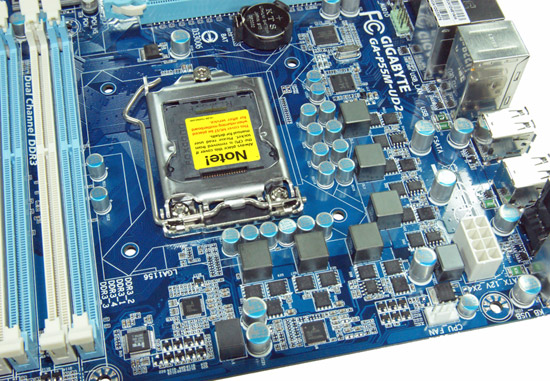
Gigabyte utilizes a solid six-phase PWM setup on this board. The CPU area is open for the most part and will accommodate larger coolers like the Thermalright MUX 120. Large push/pull coolers like the Vigor Monsoon III LT will block the first DIMM slot. If you plan on running this board with Bclk rates above 170 or so, we suggest additional airflow across the MOSFETs to ensure 24/7 stability when overclocking.
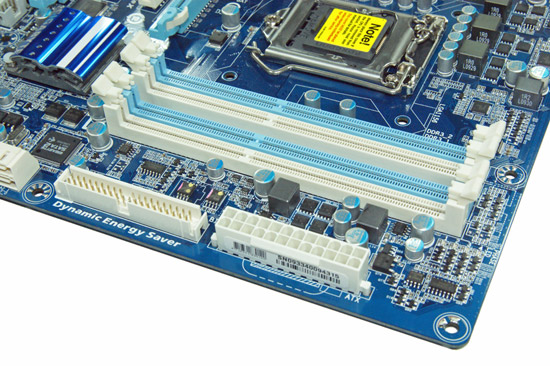
The IDE port, 24-pin ATX power connector, and the four DIMM slots are located in the lower right hand corner of the board. This board supports dual channel memory configurations and 16GB of DDR3 memory when using 4GB DIMMS. Installing the memory with a video card inserted in the first slot is difficult but not impossible.
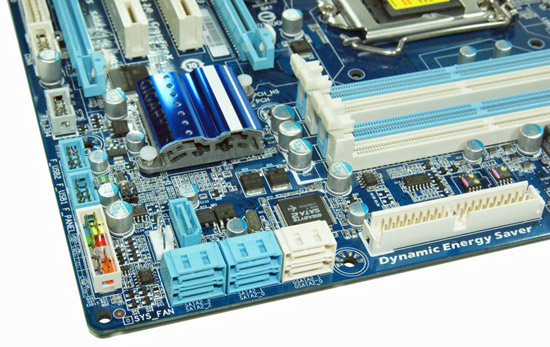
There are five (blue) SATA 3Gb/s ports provided by the P55 chipset that support RAID 0, 1, 5, 10. The sixth port available on the P55 (under the blue heatsink) is utilized on the I/O panel for eSATA. Gigabyte includes the JMicron JMB363 3Gb/s SATA chip that drives the two white SATA ports and provides IDE support. The front panel header, two USB headers, and the IEEE 1394a header are located at the edge of the board.
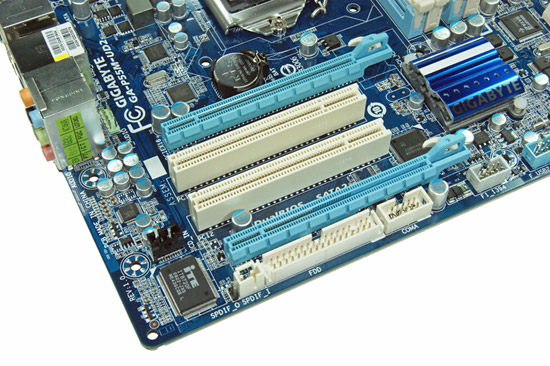
Gigabyte includes two PCIe x16 slots (x16 operation for the first slot, x4 operation for the second slot) and two PCI slots. The first PCI slot will be unavailable when utilizing a dual slot video card.
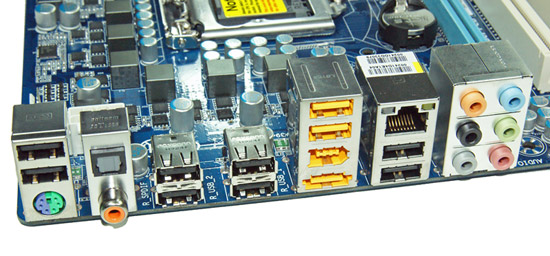
Last but not least is the I/O panel. We have ten USB 2.0 ports (total of fourteen on the board), combination PS/2 port, single eSATA port, IEEE 1394a port offered by the TI TSB43AB23 chipset, Gigabit Ethernet LAN port via the Realtek RTL8111D chipset, optical out/coaxial out S/PDIF ports, and the audio panel that provides 8-channel audio output via the Realtek ALC 888B HD audio codec.
BIOS Information
Apparently this preview did not have enough substance in it according to a few reader comments. I totally agree. However, I will state this one more time, we are bound by an NDA and cannot provide that substance for another week or so. That said, we can now show the general layout of the BIOS, thus providing a little more substance than we had yesterday. I will leave it at that for now.

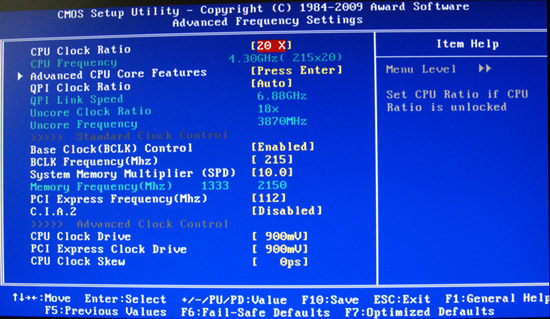
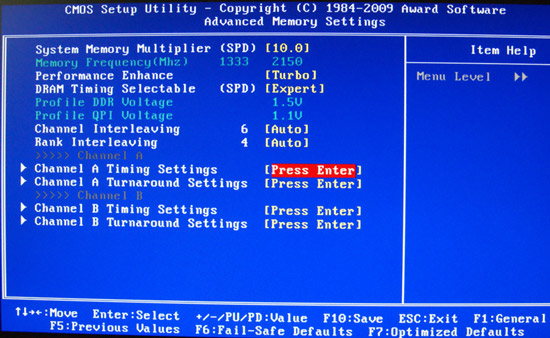


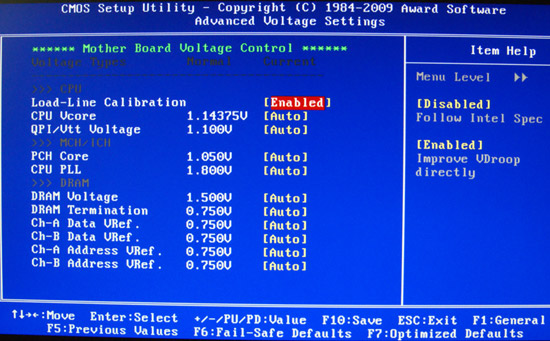






















76 Comments
View All Comments
SPianw - Saturday, August 29, 2009 - link
jesus christ dude, how much goddamn sand do you have crammed up your vagina.no, this article did not give us the data we all want. it's not that big a deal. so what if it's "fluff"?
at the very least it cost me a minute of my time to look at a motherboard that I may or may not be interested in. TIME TO REAGGEE IUOIUDSHFIU)(UOioifoh0uffffffffffffffffffffffff
SPianw - Saturday, August 29, 2009 - link
I mean seriously, man. it's not that big of a deal. take a bath, smoke a bowl.PopcornMachine - Saturday, August 29, 2009 - link
Ok. Us non-brain damaged people know they can't do that right now.And I appreciate everything they can show and tell us now.
I don't see how you behavior like a infantile little brat is going to change their NDA with Inel.
I guess some people need to let the whole world know what ignorant SOBs they are.
TA152H - Saturday, August 29, 2009 - link
Learn how to spell Intel before you insult people.If you weren't a complete idiot, you'd see I was suggesting they spend time on real articles on products they could give information on. Not on those they can't. But, you were too stupid to see that?
Buy a book. If you have any money.
PopcornMachine - Saturday, August 29, 2009 - link
Moooooooooooooooooooo...whatthehey - Saturday, August 29, 2009 - link
Ah, this is the part I love:"Actually, I did write an article for another site, and it took me over 100 hours to write, and was much more informative than this junk that has no information. I won't push the link, since it would be self-serving and not appropriate for another site, but, you can do a search on History of Mainframes on Google if you're interested. I wasn't crazy about the editing, but, the amount of effort put in the article should be obvious, compared to this plain crap."
Assuming that's truly correct, he wrote the recent article on Tom's Hardware about the "Complete History of Mainframe Computing". That explains a LOT about his posting habits here. Of course he needs to rip on a competing site. LOL (Though it does look like it's only one article for them at present.)
FWIW, writing one article -- even if it does take you 100 hours -- isn't the same as writing a REVIEW... or in this case a PREVIEW. It's good to have some idea of what motherboards will be out when P55 officially launches, and I hope AT is able to post a thorough roundup rather than wasting a bunch of time rehashing these previews. If that's the point of the previews, I'm all for it. What I do know is that completing a comprehensive REVIEW of motherboards is anything but easy, especially when BIOS updates are involved.
Gary, my request is that you stick to whatever the manufacturers have available, focus on the initial stability, features, and overclocking capability (and stock performance, though it will all be about the same). Then, AFTER the first reviews are complete, if you have time go back and tell us about how updated BIOS revisions help address initial problems. Please do NOT repeat all the tests (multiple times) when they fail because of an early BIOS. I want to know what I'm getting out of the box, not what I get if I buy an expensive motherboard that won't work properly without a BIOS flash. I'm sick of the stupid BIOS treadmills; if it doesn't work right, don't release it to the public -- lost sales be damned.
Gary Key - Monday, August 31, 2009 - link
"Gary, my request is that you stick to whatever the manufacturers have available, focus on the initial stability, features, and overclocking capability (and stock performance, though it will all be about the same). Then, AFTER the first reviews are complete, if you have time go back and tell us about how updated BIOS revisions help address initial problems. Please do NOT repeat all the tests (multiple times) when they fail because of an early BIOS. I want to know what I'm getting out of the box, not what I get if I buy an expensive motherboard that won't work properly without a BIOS flash. I'm sick of the stupid BIOS treadmills; if it doesn't work right, don't release it to the public -- lost sales be damned. "We locked down the manufacturers with retail BIOS releases this weekend. I will not be retesting the boards with new BIOS releases during this week. I met personally with just about every board supplier and they have a full understanding of what we discovered over the past three weeks in regards to problems. ;)
I will follow up a few days after the launch article with updates on any BIOS releases we receive this week that fix problems or create new ones. Otherwise, all of the clean testing this week is with BIOS releases on the boards as they shipped or from the websites as of Saturday. The same holds true for drivers and applications. Honestly, it will probably take three articles to cover every aspect, especially the hardcore overclocking, that one will be handled separately on the top three or four boards. I have another five boards coming tomorrow, so those will have to wait a few days.
Anyway, this is what I can say now, a few boards are good to go, a few need a lot of work between now and retail release. :)
TA152H - Sunday, August 30, 2009 - link
Actually, I am just as irritated with other sites for these absurd picture articles of motherboards, with no results.I mean, I realize these guys aren't real writers, and have no writing talent, but they can do better than this. It's like all these sites have prostituted themselves with these stupid motherboard pictorals, of a brain-damaged design. If it were something brand new, and the best of breed, I could see the build up. But for a mid-range offering? Bizarre.
The article actually took over 100 hours, I wasn't counting. Probably more like 150. A review would take less time, except for testing, especially considering the amount of time these places take in actually working on the writing style. There is effectively no effort there; they write like fifth graders. The transitions are weak, phraseology uninteresting, and vocabulary and style prosaic. Most of the time is spent testing. It's different, but a lot easier waiting for a benchmark to run, than actually actively making changes, triple-checking facts, and making sure the article flows and is actually interesting. Writing an article about something people are already interesting is easy. Writing an article about something not particularly relevant, or at least perceived to be, is much more difficult since it requires much better language skills, organization, and effort to make it interesting.
A baboon could write an article on a new processor, and everyone will read it, because the processor is interesting. The writing style is secondary. But, an article on something like a insides of the original IBM PC? It's a different animal, and requires a lot more skill to be effective.
Most people who read these sites fancy themselves as being technically savvy, when in reality they don't understand a lot of the technologies beyond a very rudimentary level. Getting them to learn beyond that level, and keeping it palatable, is kind of difficult. That's the biggest challenge in writing technical articles.
Penti - Sunday, September 6, 2009 - link
Man it's too early for results the shit needs to work properly first and theres a lot of testing with new boards like this. Just get over it, anandtech delivers excellent reviews when they are ready too. It's great that they do describe all the difficulties and work so close to the makers. It's nothing brain-damaging about beta testing and working out kinks in the products the enthusiast eventually will own. A lot of enthusiast will own i5's. Just deal with it. It's relevant for AT to cover it. They cover a lot of things that aren't the high-end of the high-end.charlie2 - Monday, August 31, 2009 - link
'Writing an article about something people are already interesting is easy. 'What happened to your superior writing and editing skills in this sentance? Perhaps Tom's has no room for you and now you've decided to see if you can bulldoze your way in here?